On the Synergy in the Sustainable Development of Cultural Landscape in Traditional Villages under the Measure of Balanced Development Index: Case Study of the Zhejiang Province
Abstract
:1. Introduction
2. Materials and Methods
2.1. Cultural Landscape in Traditional Villages
2.2. Study Area
2.3. Establishment of the Index System
2.4. Measurement Methods
- Dimensionless processing
- 2.
- Entropy weight determination
- 3.
- Measurement of balanced development level
2.5. Data Sources and Processing
3. Results
3.1. Analysis of Balanced Development Level
3.1.1. Overall Level Fluctuates Upward
3.1.2. Low Level of Urban–Rural Synergy Index
3.1.3. High Weight of Public Culture Indices
3.2. Synergy of Cultural Landscape in Traditional Villages
3.2.1. Characteristics of Synchronicity: Growth Synergy
- The numbers of five cities remain to be improved. The traditional villages in Lishui, Jinhua, and Taizhou are significantly aggregated, accounting for 68.6% of the 11 prefecture-level cities in Zhejiang Province, and their number is significantly negatively correlated with the degree of local economic development and transportation convenience. In sharp contrast, the traditional villages in Zhoushan, Huzhou, Shaoxing, Ningbo, and Wenzhou only account for 14.3%, and nearly every batch shows single-digit or even zero growth;
- The average annual growth rate slows down segment by segment in the three segments studied, with the average values of S1, S2, and S3 being 0.855, 0.532, and 0.241, respectively, showing an overall trend of gradual saturation of traditional villages. Except for the S1 values of Lishui, Taizhou, Quzhou, and Hangzhou and the S2 value of Taizhou which exceeds 1, the other annual average growth values are below 1. Among them, the S3 value of Taizhou drops precipitously, and it starts to exhibit an end in growth. The number of traditional villages in Shaoxing is not good on the whole, but the trend of “forging ahead” is obvious;
- Seven cities showed no synergy. Among the 10 cities studied, only Jinhua showed synergy in the growth of the number of traditional villages (C value of 1.726), and only Wenzhou and Quzhou showed relative synergy (C values of 1.641 and 1.618, respectively), indicating that the spatial growth of traditional villages in these three cities from 2012 to 2018 was coordinated and relatively orderly; however, Jinhua and Wenzhou were synergistic at low growth rates. The remaining seven cities all showed no synergy (C value below 1.55), and the number of traditional villages in Lishui continued to show blowout growth in the third, fourth, and fifth batches, which enhanced the instability of the synergy values, but with a good growth trend. The S values of Hangzhou in the three study segments were halved, segment-by-segment, as the traditional villages were highly impacted by the rapid urbanization, which led to a decrease in the synergy coupling of their growth number.
3.2.2. Characteristics of Diachronism: Aggregation Synergy
- Significant self-similarity fractal (good linear fitting, determination coefficient R2 above 0.890) and the existence of scale-free sections, especially in the fourth batch of scale-free sections, Longquan City and Xianju County within the range of (3.1, 5.1) showed enhanced aggregation;
- The aggregation dimensions are less than 2, indicating that the attenuation from the central village to the peripheral circles is obvious. Around the three spatial influence centers/palms, that are, “Songyang-Wuyi”, “Jingning-Longquan”, and “Lanxi”, there shows a spatial pattern of “three centers, five fingers, multiple points”;
- The aggregation dimension increases after decreasing (values of 1.340, 0.850, 0.365, 0.963, and 1.239), indicating that the degree of aggregation increases and then decreases, i.e., from the first batch of “free distribution state,” the second batch of “centripetal scattering aggregation state,” and the third batch of “central bursting state,” evolving to the fourth batch of “polycentric aggregation state” and the fifth batch of “centrifugal fractal state”.
4. Discussion
4.1. “Diverse Synergy” Driving Sustainable Spatial Development
4.2. “Culture-Fostering-Aspiration” to Drive Sustainable Social Development
4.3. “Digital-Fostering-Intelligence” to Achieve Sustainable Industrial Development
5. Conclusions
- From the perspective of complexity theory, to categorize and explore the unique regionalism, spatial–temporal correlation, and chaotic complexity in the genetic expression and iconographic language of cultural landscape in traditional villages, and to refine typical schemes to form “demonstrations”;
- Going in-depth to the cultural landscape theory, to vertically outline the regional spatial pattern management system, implementation paths in classifications and grades, and development priorities in steps of timing sequence of heritage conservation and utilization in traditional villages, famous historical and cultural villages, and the historical and cultural villages at the national and provincial levels;
- Based on a comprehensive qualitative and quantitative perspective, to horizontally sort out the association and differences in spatial patterns and influencing factors among national-level traditional villages, national-level key villages of rural tourism, and national-level key precise poverty alleviation areas, thus providing guidance and suggestions for sustainable development in rural areas.
Author Contributions
Funding
Institutional Review Board Statement
Informed Consent Statement
Data Availability Statement
Conflicts of Interest
References
- The Sustainable Development Agenda. Available online: https://www.un.org/sustainabledevelopment/development-agenda/ (accessed on 15 May 2022).
- Wang, J.; Huang, J.; Feng, Z.; Cao, S.; Haghighat, F. Occupant-density-detection based energy efficient ventilation system: Prevention of infection transmission. Energy Build 2021, 140, 110883. [Google Scholar] [CrossRef] [PubMed]
- Fan Conglai; Xie Chaofeng. Pro-poor growth and the realization of common prosperity of socialism with Chinese characteristics. China Political Econ. 2018, 1, 207–218. [Google Scholar] [CrossRef]
- Michael Dunford. The Chinese Path to Common Prosperity. Int. Crit. Thought 2022, 12, 35–54. [Google Scholar] [CrossRef]
- Li, S.; Chen, J.P.; Teng, Y.C. Rural Revitalization on the Path of Common Prosperity:Problems, Challenges and Suggestions. J. Lanzhou Univ. 2021, 49, 37–46. [Google Scholar]
- Tang, R.W.; Li, C.Q. The Realization of Common Prosperity:An Investigation Based on the “Three-wheel Drive” of Market, Government and Society. J. Xinjiang Norm. Univ. Ed. Philos. Soc. Sci. 2022, 43, 49–58. [Google Scholar]
- Tian, W.H. Research Coordinated Development of Stable Poverty Alleviation and Rural Revitalization. Agric. Econ. Manag. 2021, 2, 11–21. [Google Scholar]
- Garrone, M.; Emmers, D.; Olper, A.; Swinnen, J. Jobs and agricultural policy: Impact of the common agricultural policy on EU agricultural employment. Food Policy 2019, 87, 101744. [Google Scholar] [CrossRef]
- Gevelt, T.V. Rural electrification and development in south korea. Energy Sustain. Dev. 2014, 23, 179–187. [Google Scholar] [CrossRef]
- Ma, L.; Liu, S.; Fang, F.; Che, X.; Chen, M. Evaluation of urban-rural difference and integration based on quality of life. Sustain. Cities Soc. 2020, 54, 101877. [Google Scholar] [CrossRef]
- Herberholz, C.; Phuntsho, S. Social capital, outpatient care utilization and choice between different levels of health facilities in rural and urban areas of Bhutan. Soc. Sci. Med. 2018, 211, 102–113. [Google Scholar] [CrossRef]
- Ji, X.; Ren, J.Y.; Ulgiati, S. Towards urban-rural sustainable cooperation: Models and policy implication. J. Clean. Prod. 2019, 213, 892–898. [Google Scholar] [CrossRef]
- Hu, B.; Li, X.; Wang, X. Blue Book of Chinese Traditional Villages—Investigation Report on the Projection of Chinese Traditional Villages; Social Science Academic Press: Beijing, China, 2017. [Google Scholar]
- National Bureau of Statistics of China. China Statistical Yearbook 2020; China Statistics Press: Beijing, China, 2020. [Google Scholar]
- Feng, J.C. The predicament and way out of traditional villages—traditional villages are another cultural heritage. Folk. Cult. Forum 2013, 1, 7–12. [Google Scholar]
- Wu, P. Authenticity protection and construction of traditional villages in Qiandongnan, Guizhou—Thinking based on the goal of beautiful rural construction. Guizhou Soc. Sci. 2018, 1, 92–97. [Google Scholar]
- Hu, B.B.; Hu, C. Introduction to Chinese traditional village culture; China Social Sciences Press: Beijing, China, 2019; p. 4. [Google Scholar]
- Antrop, M. Why landscapes of the past are important for the future. Landsc Urban Plan. 2005, 70, 21–34. [Google Scholar] [CrossRef]
- Huang, L.; Yan, Y. Research on the cultural protection and living inheritance of traditional villages in northern Guilin from the perspective of rural revitalization—Taking traditional villages in Lingchuan County, Guilin City as an example. J. Guilin Univ. Aerosp. Technol. 2022, 1, 128–133. [Google Scholar]
- Zhang, X.C.; Gao, N.; Sun, L.W. Spatial- temporal matching pattern and interaction between Chinese traditional village and tourism development factors. J. Shaanxi Norm. Un Iversity 2021, 49, 30–42. [Google Scholar]
- Berdegué, J.A.; Proctor, F.J.; Cazzuffi, C. Inclusive Rural–Urban Linkages. Working Group: Development with Territorial Cohesion; No. 123; Working Paper Series; RIMISP: Santiago, Chile, 2014. [Google Scholar]
- Fowler, P.J. World Heritage Paper 6: World Heritage Cultural Landscape 1992–2002; UNESCO World Heritage Centre: Paris, France, 2003; p. 22. [Google Scholar]
- Schmitz, M.F.; Herrero-Jáuregui, C. Cultural Landscape Preservation and Social–Ecol ogical Sustainability. Sustainability 2021, 13, 2593. [Google Scholar] [CrossRef]
- Yang, Y.L.; Zhang, D.M.; Dang, A.R.; Xie, H.Y. A Study on Spatial and Time Characteristics of Forming Mechanism of Village Cultural Landscape Illustrated by the Example of Nuodeng Village. Chin. Landsc. Archit. 2013, 29, 60–65. [Google Scholar]
- World Heritage Centre—UNESCO. Operational Guidelines for the Implementation of the World Heritage Convention; UNESCO: Paris, France, 2017. [Google Scholar]
- Ebenezer Howard. To-Morrow—A Peaceful Path to Real Reform; China Architecture & Building Press: Beijing, China, 2020. [Google Scholar]
- Ruda, G. Rural buildings and environment. Landsc. Urban Plan. 1998, 41, 93–97. [Google Scholar] [CrossRef]
- Vos, W.; Meekes, H. Trends in European cultural landscape development: Perspectives for a sustainable future. Landsc. Urban Plan. 1999, 46, 3–14. [Google Scholar] [CrossRef]
- Shao, Y.; Ruan, Y.S. On the legal construction of historical and cultural heritage protection—Enlightenment from the development of French historical and cultural heritage protection system. Urban Plan. Forum 2002, 3, 57–60+65–80. [Google Scholar]
- Qin, Y.H.; Wu, X.; Yin, Z.G.; Yao, L.L. Stones from other mountains can attack jade—The enlightenment of German rural construction to Dongting Lake. Agric. Archaeol. 2008, 3, 121–123. [Google Scholar]
- Lu, Z.R. Japan’s Cultural Relics Protection Policy and Enlightenment. Chin. Mus. 2010, 4, 28–30. [Google Scholar]
- Li, T.Y.; Zhai, H.; Hu, K.Y. Scenes, People, and Spirit- Study on the Protection of Traditional Villages in Shangri- La from the Perspective of Cultural Landscape. Chin. Landsc. Archit. 2020, 36, 37–42. [Google Scholar]
- Liu, X.B.; Gao, W. Institutional Empowerment: Community Participation in the Conservation of Traditional Village Cultural Landscape of Guangdong Kaiping Watchtower. Chin. Landsc. Archit. 2016, 32, 121–124. [Google Scholar]
- Wang, Y.C. The Pattern Language and Its Inheritance of Traditional Local Cultural Landscape. Chin. Landsc. Archit. 2009, 25, 73–76. [Google Scholar]
- Lin, L.; Tian, J.S.; Zhiping, Z.H.O.N.G.; Shiyuan, L.I.; Bingxun, R.E.N. Protection and Renewal of Traditional Villages from the Perspective of Cultural Gene: A Case Study of Northeast Guizhou Tujia Minority. Trop. Geogr. 2018, 38, 413–423. [Google Scholar]
- Ji, J.J.; Xiao, D.W. The Jiujia Settlements Beside Nanping River: The Research of Cultural Landscape on the Multi-ethnic-populated Traditional Villages. Chin. Landsc. Archit. 2016, 32, 24–28. [Google Scholar]
- Zhang, D.N. Exploration on the Heritage of Traditional Village Cultural Landscape. Study Nat. Cult. Herit. 2017, 2, 1–8. [Google Scholar]
- Wu, L.; Yu, J.Z. Exploration on the Spatial Characteristics and Protection Utilization of Traditional Villages in Zhejiang Province. Urban Dev. Stud. 2021, 28, 32–39. [Google Scholar]
- Li, S. Spatial distribution characteristics and green tourism development strategies of traditional villages in Zhejiang Province. J. Zhejiang Agric. Sci. 2021, 62, 189–197. [Google Scholar]
- Li, T.Y.; Lu, L.; Ren, Y.S.; Zhang, X.Y.; Zhang, Q.Y. Research on the Evolution of Spatial Pattern and Influencing Factors of Traditional Villages in Zhejiang Province. Resour. Dev. Mark. 2020, 36, 626–634. [Google Scholar]
- Luo, J.J.; Zheng, X.; Fang, H. Research on the current situation of protection and utilization of traditional villages in Zhejiang Province. China Mark. 2018, 9, 32–33. [Google Scholar]
- Liu, Y.J.; Chen, Y.; Li, X.H.; Wang, Z.Y.; Deng, Z.L.; Tian, H.M. Common prosperity and coordinated regional development. Reg. Econ. Rev. 2022, 2, 5–15. [Google Scholar]
- He, L.F. Support the high-quality development of Zhejiang and build a demonstration area for common prosperity and provide a provincial example for the solid promotion of common prosperity throughout the country. Macroecon. Manag. 2021, 7, 20. [Google Scholar]
- Zheng-Jun, L.I.; Chao-Qun, W.U. Research on the Cooperative Coupling Mechanism of Traditional Village Resource Elements in Rural Revitalization-Taking Traditional Villages in the Jinhua Area of Zhejiang Province as Samples. J. Anhui Agric. Sci. 2021, 49, 205–209. [Google Scholar]
- Chen, L.J.; Yu, J.X.; Yu, Y.N. Construction of Common Prosperity Index Model. Gov. Stud. 2021, 37, 5–16. [Google Scholar]
- Ling, L.X.; Yang, G.L. Evaluation of high-quality economic development in the Guangdong-Hong Kong-Macao Greater Bay Area. Stat. Decis. 2020, 36, 94–97. [Google Scholar]
- Zhang, Z.F. Empirical study on the dissipative structure model of manufacturing systems based on entropy approach. J. Dyn. Syst. Meas. Control. Trans. Asme 2015, 137, 041003. [Google Scholar] [CrossRef]
- Keum, J.; Coulibaly, P. Sensitivity of entropy method to time series length in hydrometric network design. J. Hydrol. Eng. 2017, 22, 04017009. [Google Scholar] [CrossRef]
- Wang, F.; Chen, J.C. Preferential Appraisal of Land Consolidation Planning Scheme Based on Catastrophe Theory. Sci. Technol. Manag. Land Resour. 2007, 3, 36–39. [Google Scholar]
- Shannon, C.E. A mathematical theory of communication. Bell Labs Tech. J. 1948, 27, 379–423. [Google Scholar] [CrossRef]
- Cammi, A.; Misale, M.; Devia, F.; Cauzzi, M.T.; Pini, A.; Luzzi, L. Stability analysis by means of information entropy: Assessment of a novel method against natural circulation experimental data. Chem. Eng. Sci. 2017, 166, 220–234. [Google Scholar] [CrossRef]
- Zhu, X.G. Theory of Cultural Reform and Development: Hot and Cold Thinking of Cultural Construction; China Radio Film & TV Press: Beijing, China, 2013; p. 27. [Google Scholar]
- Cui, L.; Li, X. Research Enlightenment of Synchronic and Diachronic Space-Time in Landscape Architecture Design. Chin. Landsc. Archit. 2014, 9, 63–66. [Google Scholar]
- Haken, H. What can synergetics contribute to embodied aesthetics? Behav. Sci. 2017, 7, 61. [Google Scholar] [CrossRef]
- Traditional Village. Available online: http://www.chuantongcunluo.com/index.php/Home/gjml/gjml/wid/585.html (accessed on 30 January 2022).
- Liu, Z.H.; Hong, G.W.; Wang, J.D. Research on the Synergy Degree of the Growth of Green Space Rate of Built District and Public Recreational Green Space Per Capita in China. Chin. Landsc. Archit. 2015, 31, 120–124. [Google Scholar]
- Yang, S.F.; Hu, S.G.; Ye, J.; Tong, L.Y. Spatial-Temporal Variation and Formation Mechanism of Neo-Urbanization Development Coordination in Central China. Econ. Geogr. 2014, 34, 23–29. [Google Scholar]
- Liu, J.; Zhang, L.; Ji, Y.W.; Zhang, Q.P. Spatial-Temporal Evolution Analysis of Urban Green Space System Based on Fractal Model: A Case Study of Downtown Shanghai. Mod. Urban Res. 2019, 10, 12–19. [Google Scholar]
- Jin, Y.F.; Li, T.; Wang, C.C.; Shen, J. Optimization of Recreational Green Space System Layout Based on Fractal Quantification Model from the Perspective of Urban-rural Integration. Landsc. Archit. 2018, 25, 81–86. [Google Scholar]
- Liang, F.C.; Liu, S.Y.; Liu, L.M. Spatial characteristics and evolution of rural settlement landscape based on fractal theory: A case study of Xiamen, China. Chin. J. Appl. Ecol. 2017, 28, 2640–2648. [Google Scholar]
- Chen, Y.G. Fractal Cities and City Planning. City Plan. Rev. 2005, 2, 33–40. [Google Scholar]
- Zhu, X.G.; Wang, Y. Research on the Performance Evaluation System of Public Cultural Services: Basic Framework and Policy Recommendations. China Publ. J. 2016, 21, 29–32. [Google Scholar]
- Chen, T.; Wang, P. Information gap and practical symptoms of the digital village construction. E-Government 2020, 12, 2–12. [Google Scholar]
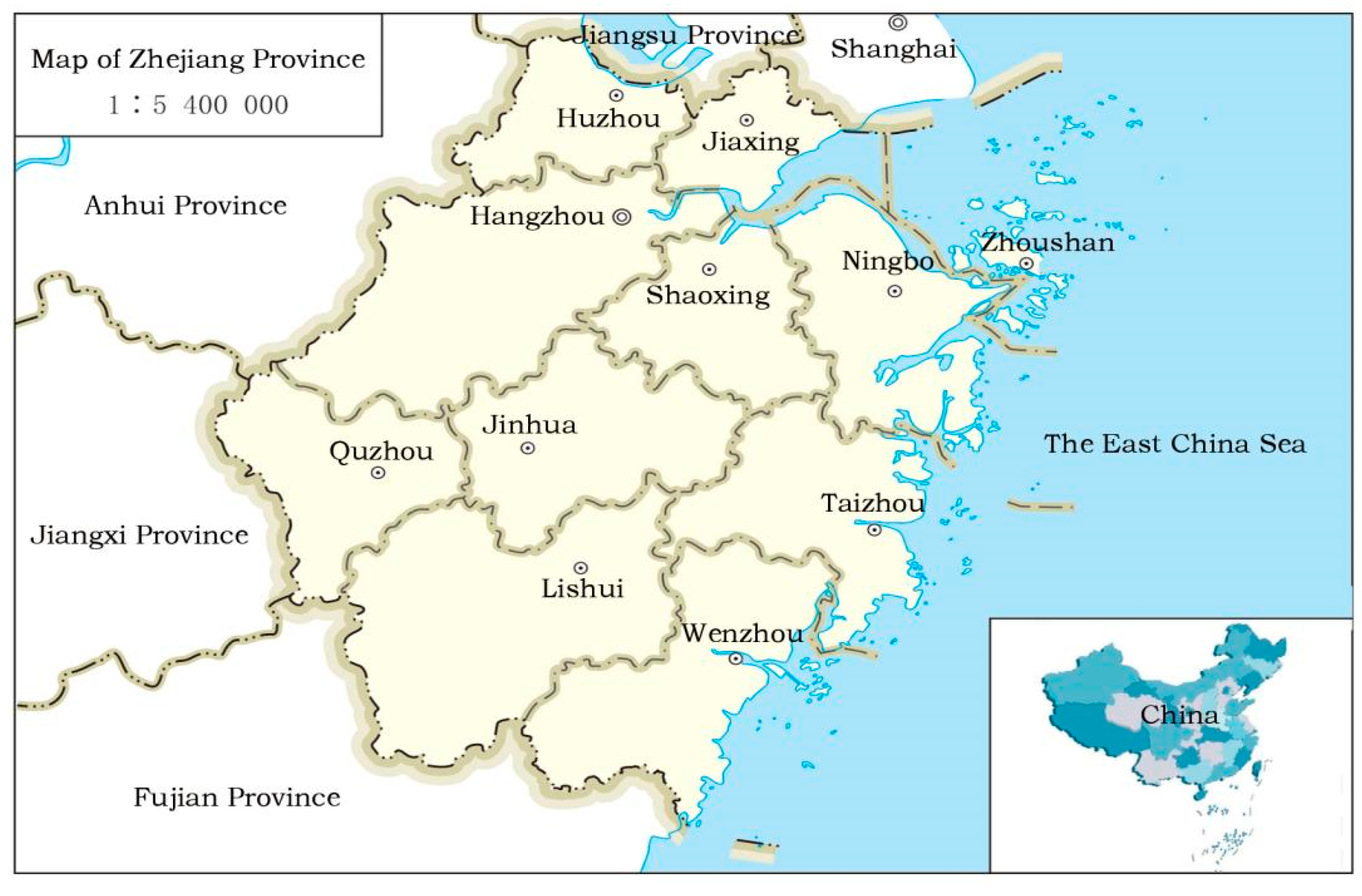
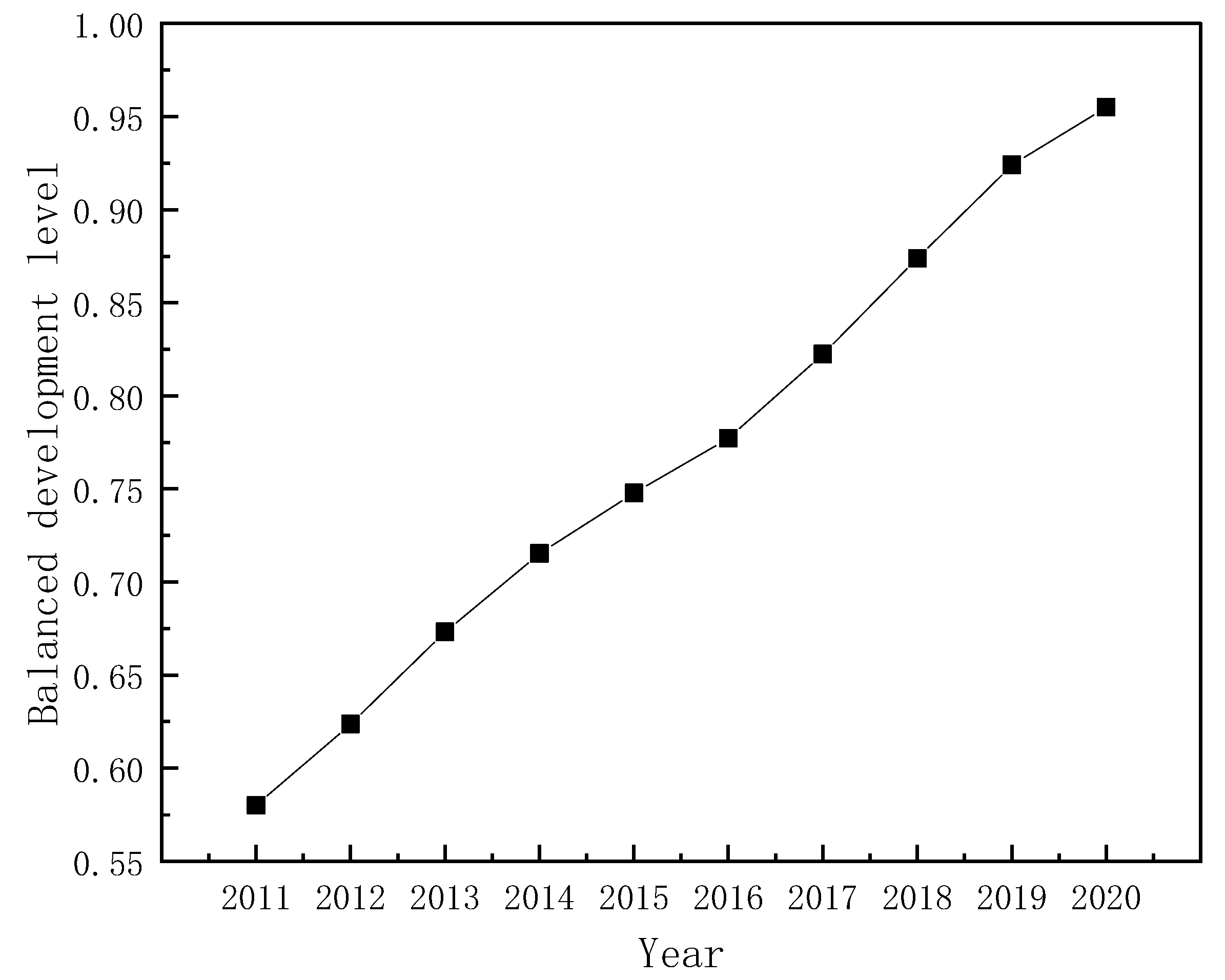
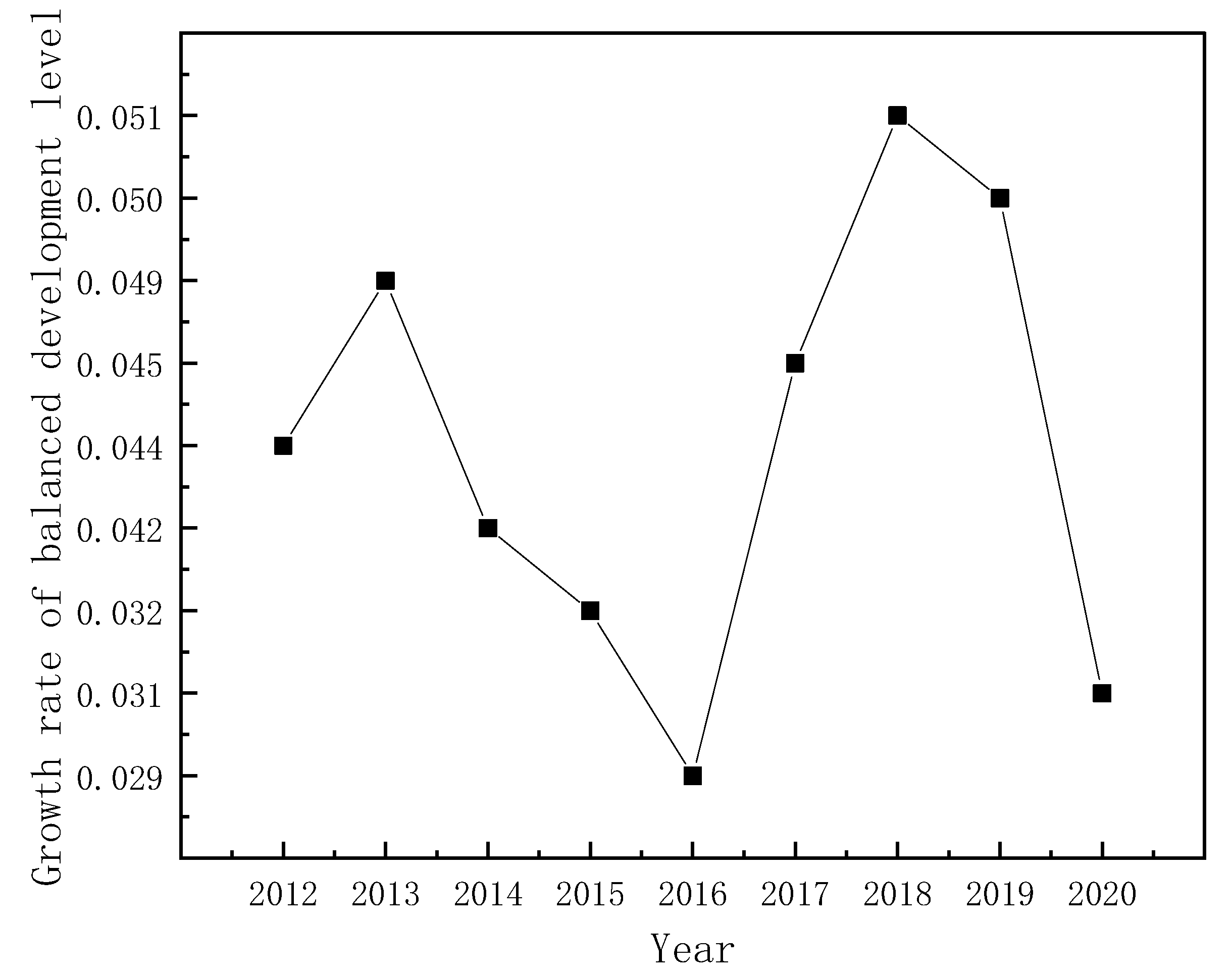
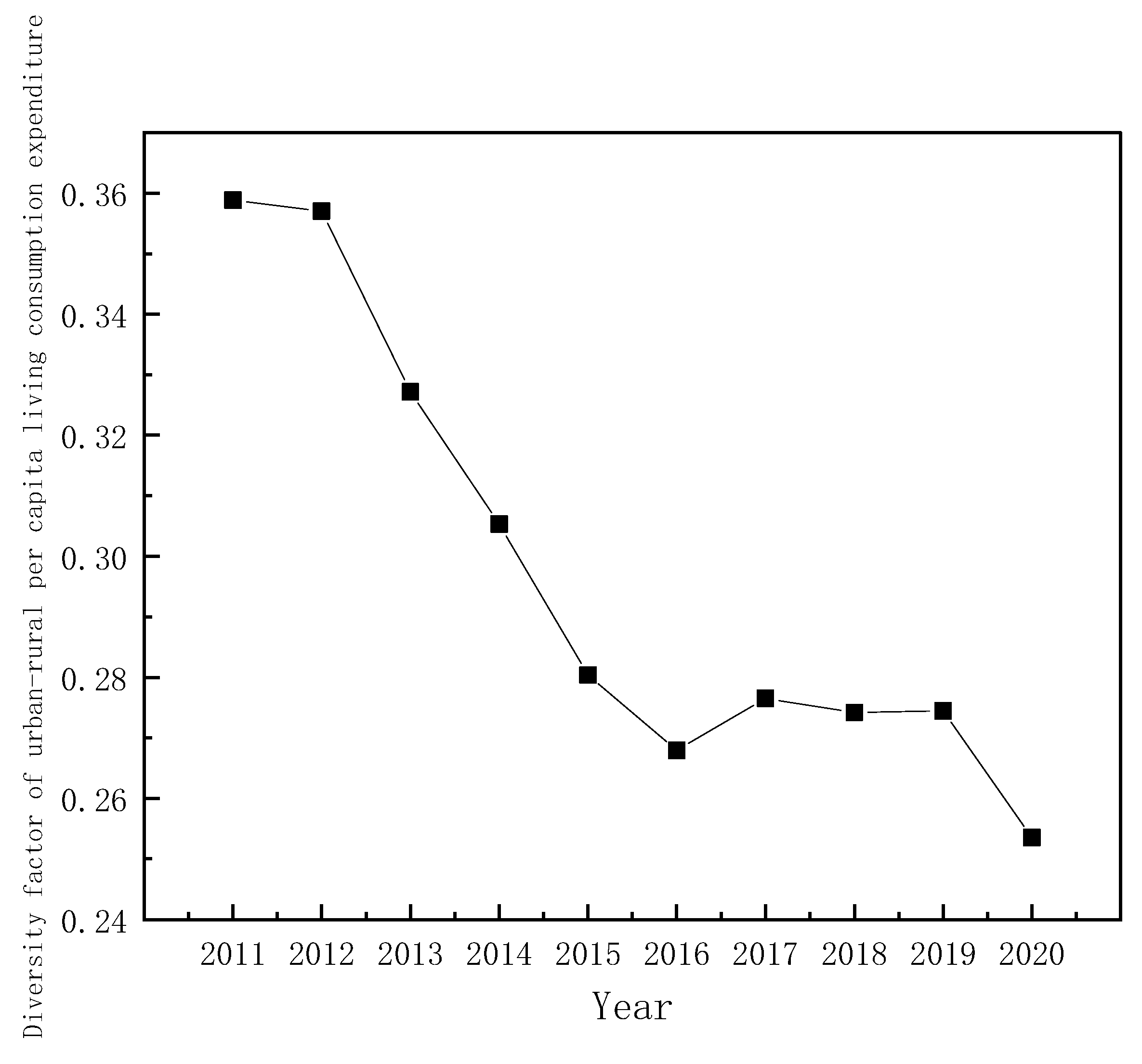
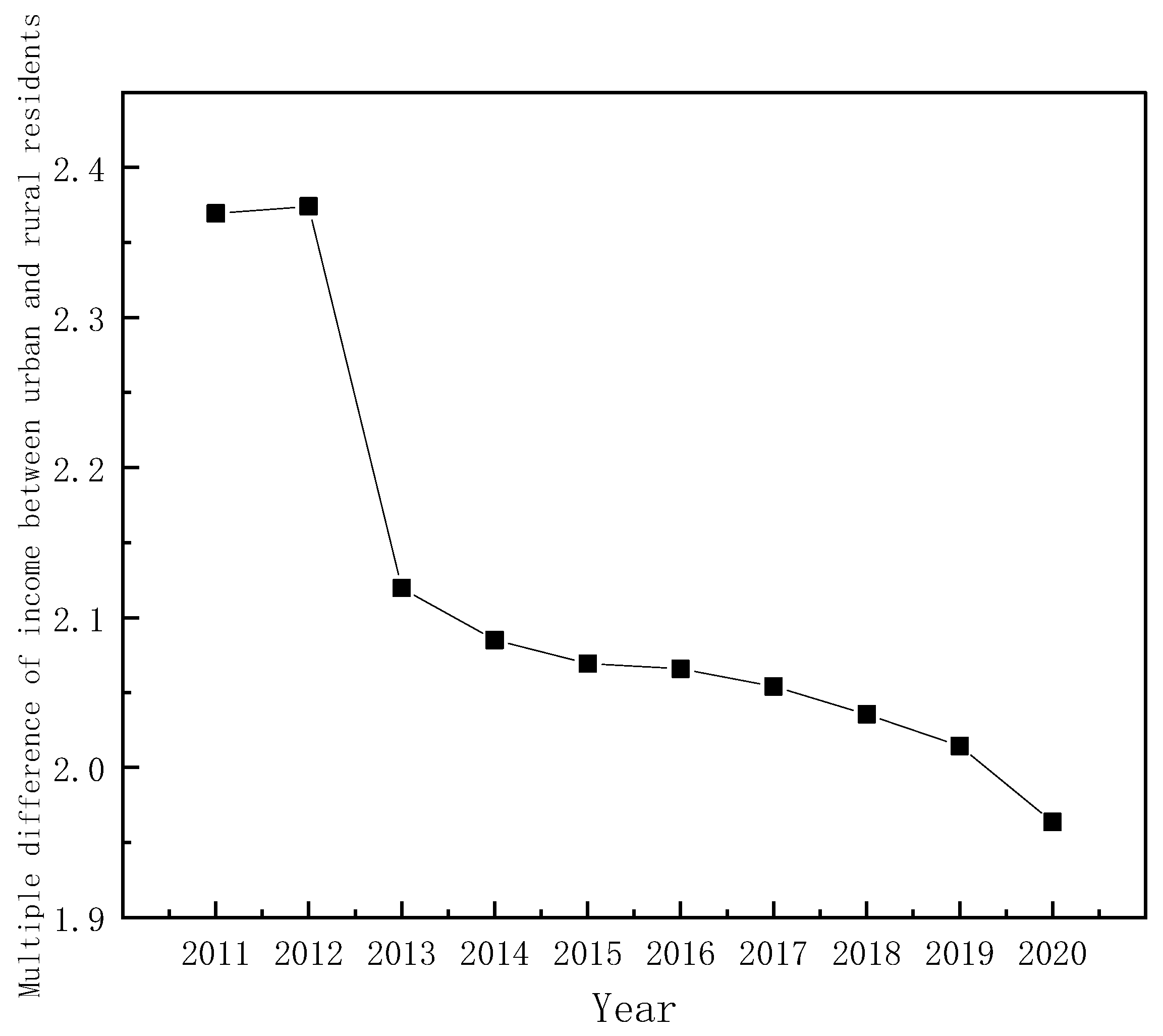
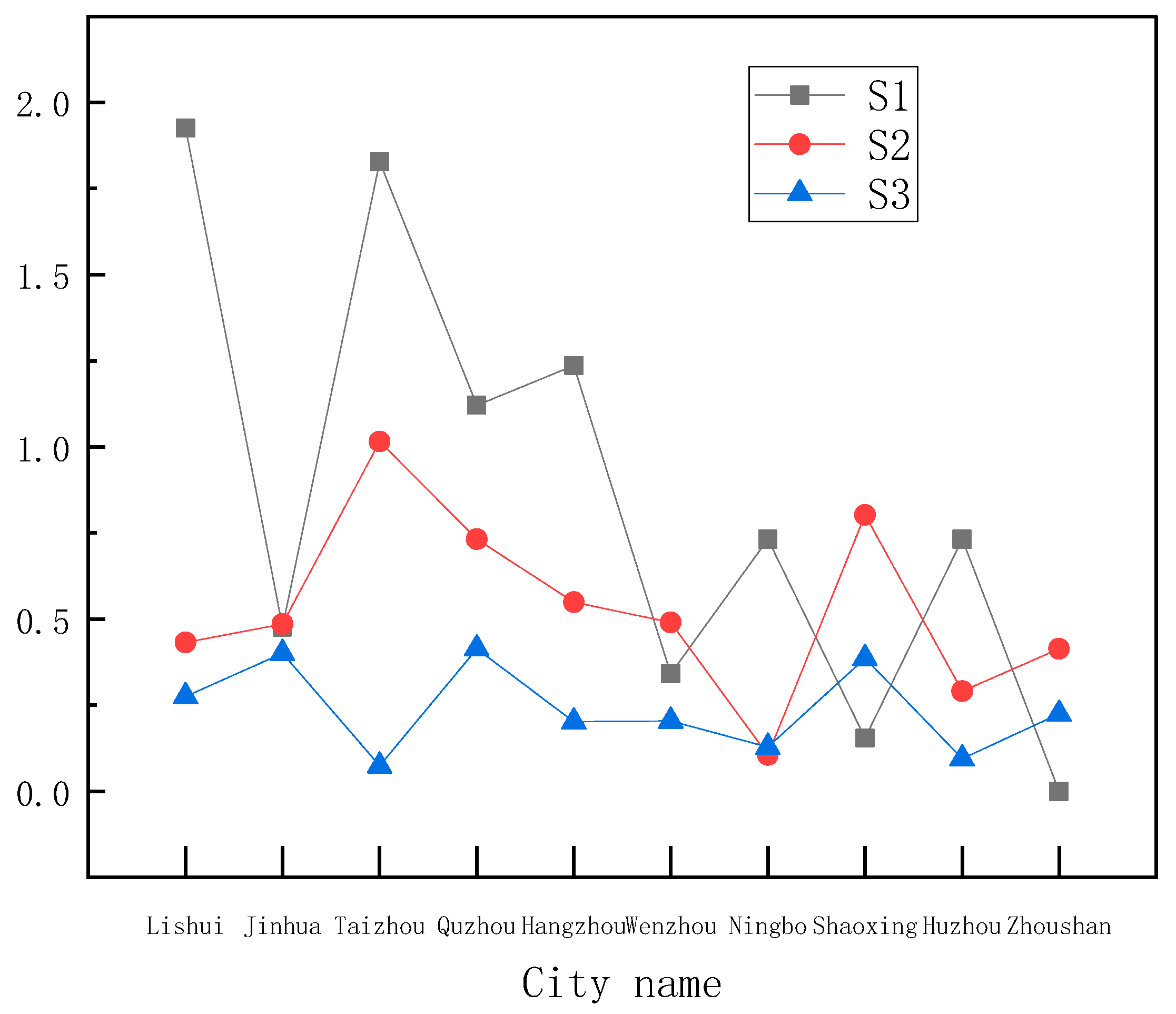
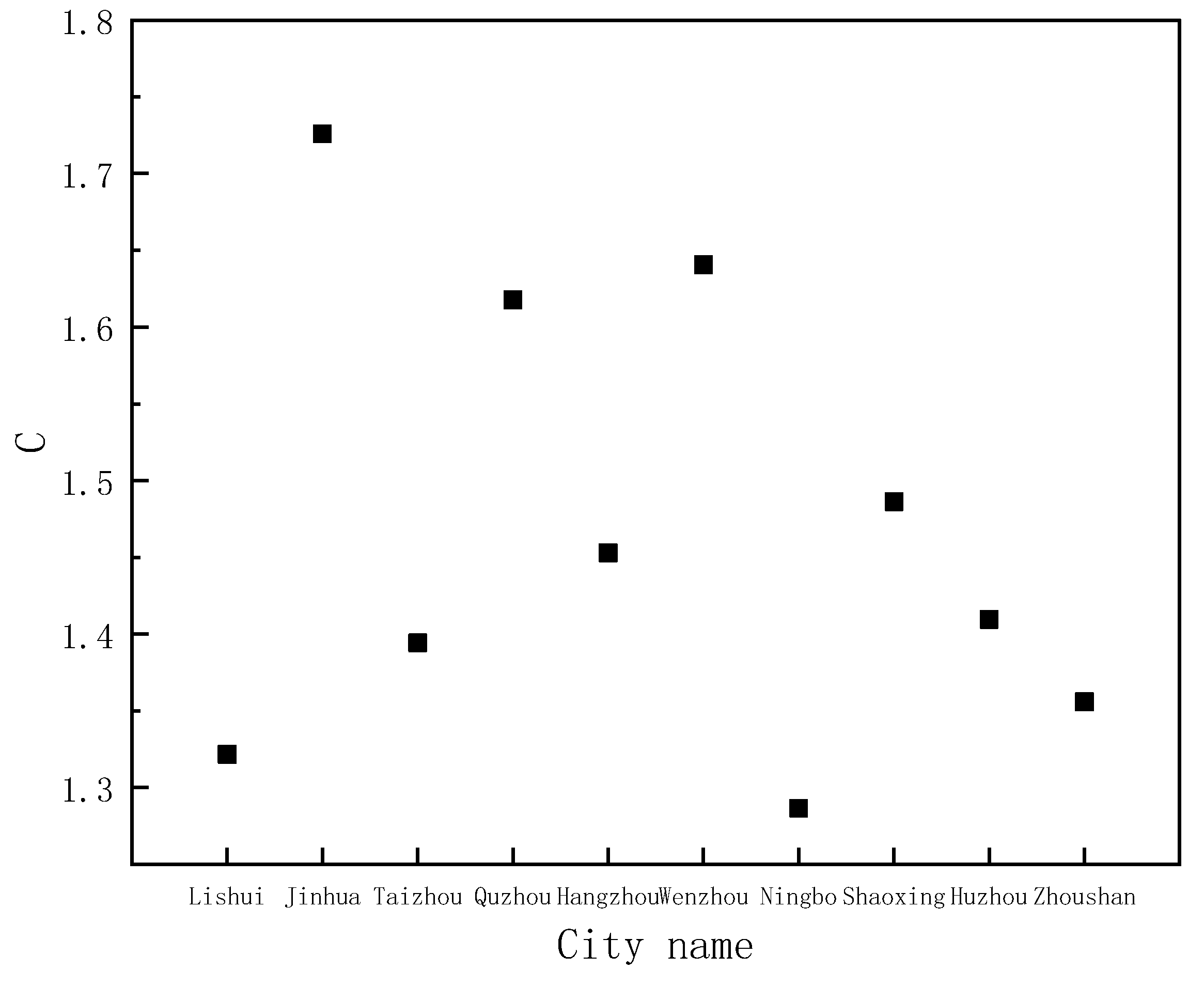
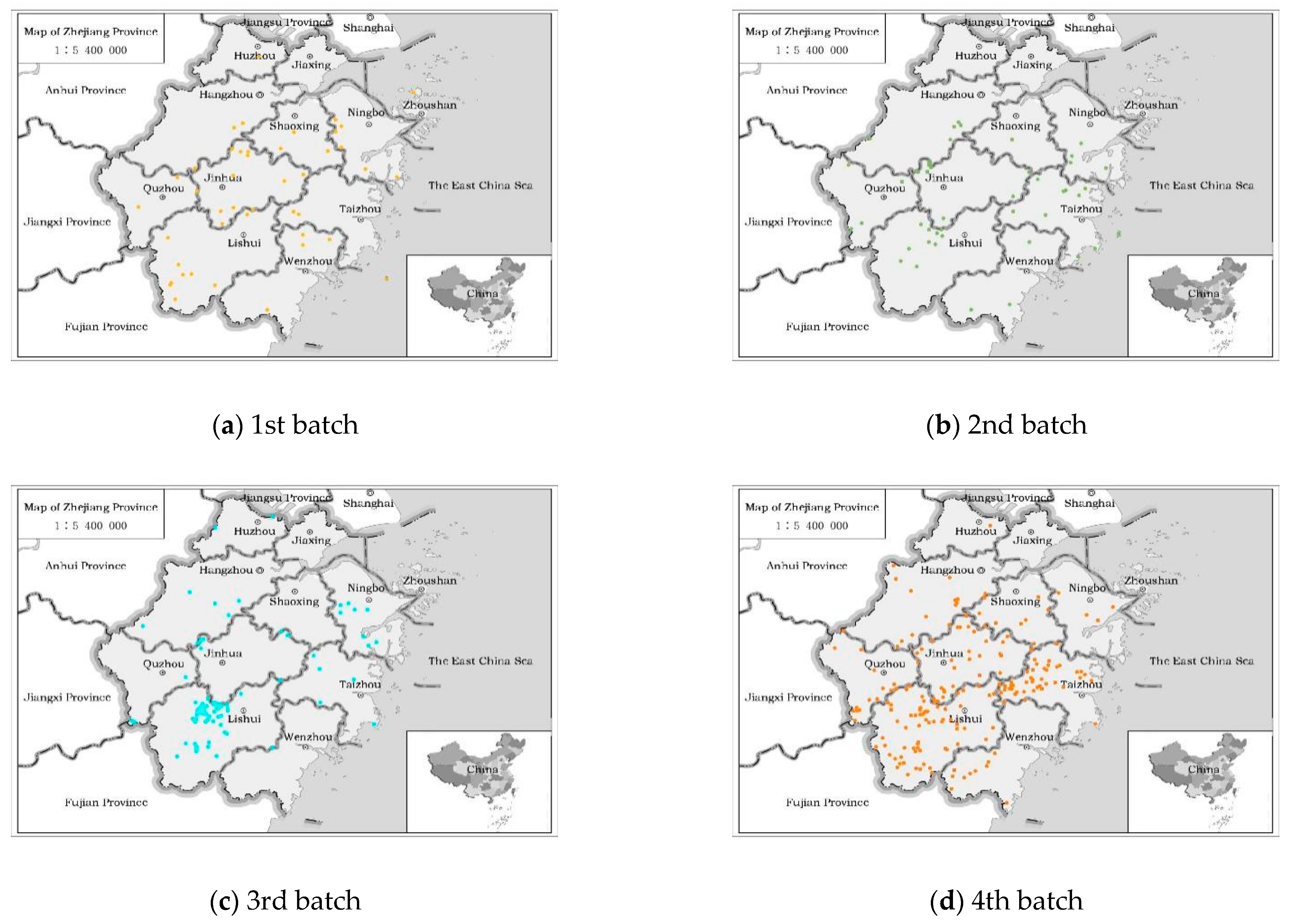
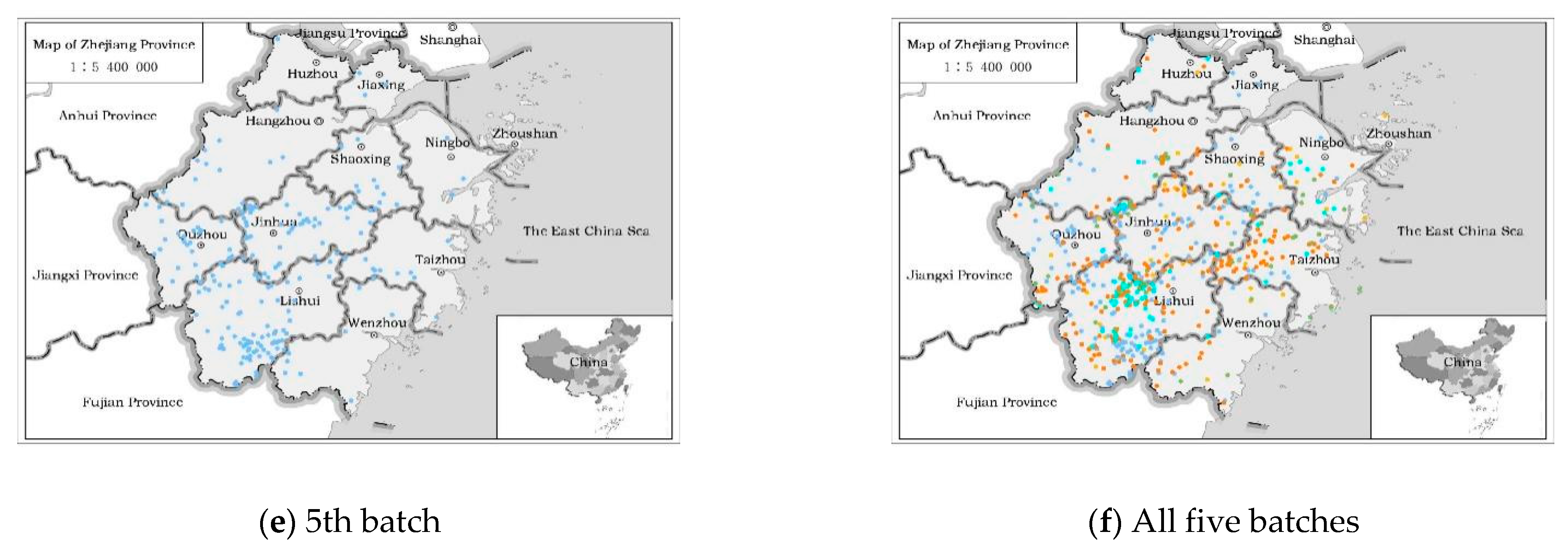
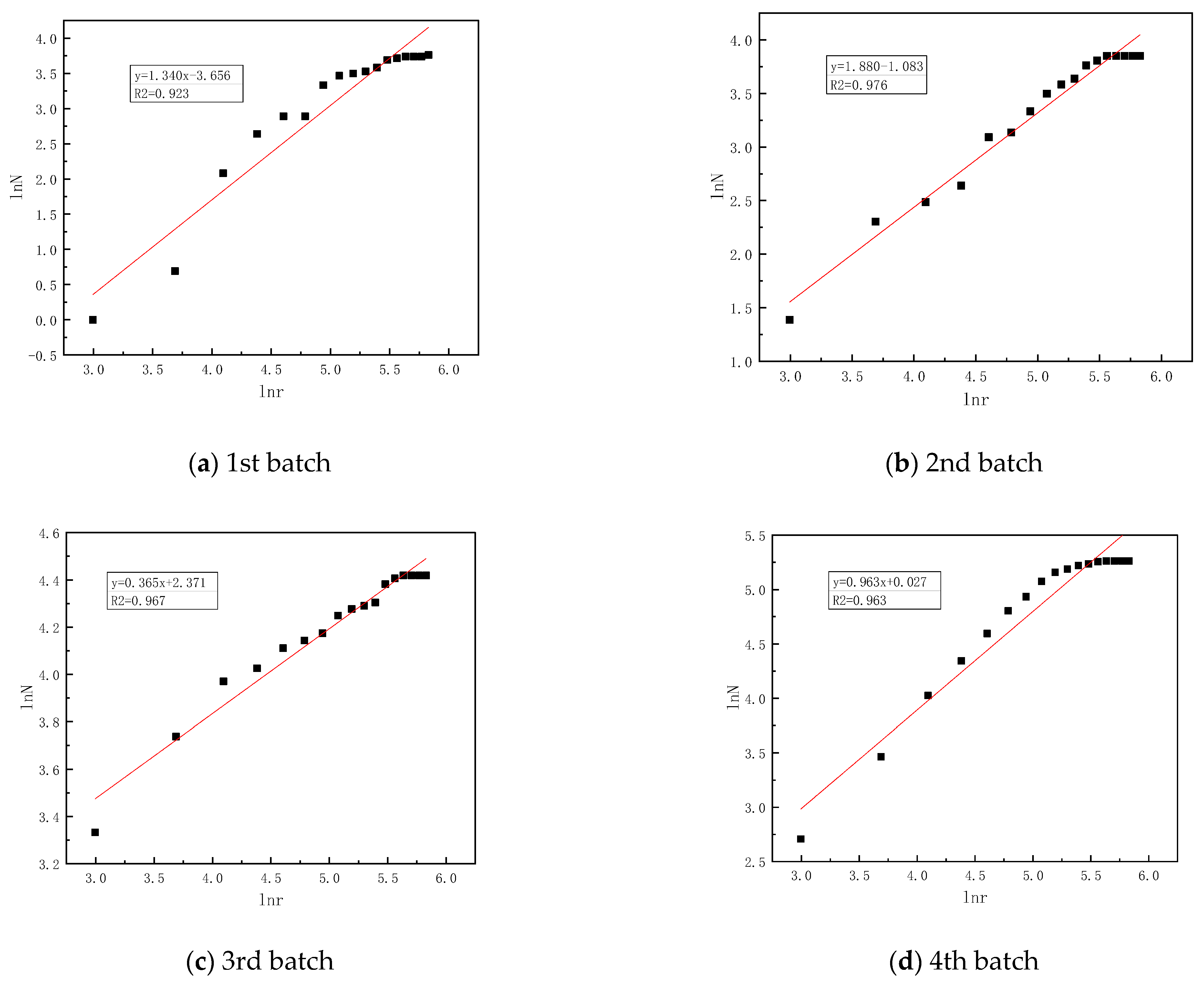
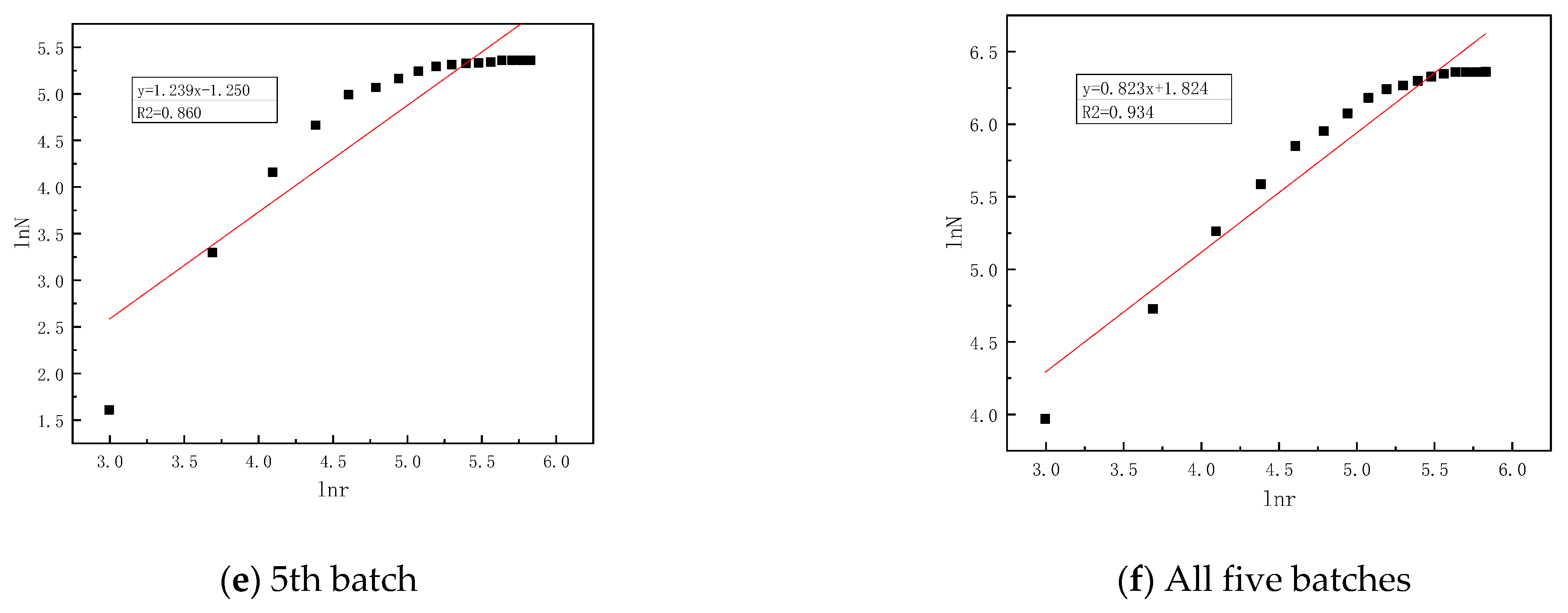

| Primary Indices | Secondary Indices | Tertiary Indices |
|---|---|---|
| Development | Affluence | ① Urban residents per capita disposable income (yuan) ② Rural residents per capita disposable income (yuan) ③ Per capita disposable income as a proportion of per capita GDP (%) ④ Urban residents per capita consumption expenditure (yuan) ⑤ Rural residents per capita consumption expenditure (yuan) ⑥ Total fixed-asset investment (100 million yuan) ⑦ Average savings deposit balance per person (yuan) ⑧ Retail price index ⑨ Consumer price index |
| Group Synergy | ① The total amount of urban security funds (100 million yuan) ② The total amount of rural security funds (100 million yuan) ③ The number of urban minimum living standards (10,000 persons) ④ The number of rural minimum living standards (10,000 persons) | |
| Urban-rural Synergy | ① Diversity factor of urban–rural per capita living consumption expenditure ② Multiple difference of income between urban and rural residents | |
| Sharing | Education | ①The average number of students per teacher in elementary schools (persons) ② The number of students in secondary schools (10,000 persons) ③ The number of students in higher education institutions (persons) |
| Medical Health | ① The number of doctors per 1000 residents (persons) ② The number of beds in medical institutions per 1000 residents (numbers) ③ Rural doctors and medical orderlies (persons) | |
| Social Security | ① Medical relief expenditure (100 million yuan / 10,000 persons) ② The number of participants in basic medical insurance (10,000 persons) ③ The number of participants in basic endowment insurance (10,000 persons) | |
| Housing | ① Rural residents per capita housing area (m2) ② Urban residents per capita housing area (m2) | |
| Public Infrastructure | ① Public transportation vehicles per 10,000 people (units) ② Wastewater treatment rate (%) ③ Per capita ownership of road area (square meters) | |
| Digital Applications | ① Cell phone popularizing rate (pcs / 100 persons) ② The number of computers per 100 rural households (units) ③ The number of computers per 100 urban households (units) | |
| Public Culture (Spiritual Wealth) | ① Total expenditure on cultural museums (stations) (10,000 yuan) ② The total collection of public libraries (10,000 copies) ③ The number of books, periodicals and literature lent (10,000 copies) | |
| Sustainability | High Quality Development | ① GDP per capita (yuan/person) ② R&D investment (100 million yuan) ③ The number of patents granted (items) ④ Urban registered unemployment rate (%) |
| Governance | ① Per capita fiscal income (10,000 yuan per person) ② The number of grassroots labor union organizations (numbers) ③ The number of lawyer staff (persons) | |
| Ecology | ① Urban greening coverage area (hectares) ② Habitation park green space (square meters) ③ Domestic waste removal volume (10,000 tons) ④ Industrial solid waste comprehensive utilization rate (%) |
| Primary Indices | Weights | Secondary Indices | Weights |
|---|---|---|---|
| Development | 0.349 | Affluence | 0.205 |
| Group synergy | 0.110 | ||
| Urban–rural synergy | 0.033 | ||
| Sharing | 0.419 | Education | 0.056 |
| Medical care and health | 0.074 | ||
| Social security | 0.076 | ||
| Housing | 0.035 | ||
| Public infrastructure | 0.030 | ||
| Digital applications | 0.065 | ||
| Public culture (spiritual enrichment) | 0.083 | ||
| Sustainability | 0.232 | High-quality development | 0.105 |
| Governance | 0.058 | ||
| Ecology | 0.069 |
Publisher’s Note: MDPI stays neutral with regard to jurisdictional claims in published maps and institutional affiliations. |
© 2022 by the authors. Licensee MDPI, Basel, Switzerland. This article is an open access article distributed under the terms and conditions of the Creative Commons Attribution (CC BY) license (https://creativecommons.org/licenses/by/4.0/).
Share and Cite
Zhu, X.-G.; Li, T.; Feng, T.-T. On the Synergy in the Sustainable Development of Cultural Landscape in Traditional Villages under the Measure of Balanced Development Index: Case Study of the Zhejiang Province. Sustainability 2022, 14, 11367. https://doi.org/10.3390/su141811367
Zhu X-G, Li T, Feng T-T. On the Synergy in the Sustainable Development of Cultural Landscape in Traditional Villages under the Measure of Balanced Development Index: Case Study of the Zhejiang Province. Sustainability. 2022; 14(18):11367. https://doi.org/10.3390/su141811367
Chicago/Turabian StyleZhu, Xu-Guang, Tao Li, and Ting-Ting Feng. 2022. "On the Synergy in the Sustainable Development of Cultural Landscape in Traditional Villages under the Measure of Balanced Development Index: Case Study of the Zhejiang Province" Sustainability 14, no. 18: 11367. https://doi.org/10.3390/su141811367
APA StyleZhu, X.-G., Li, T., & Feng, T.-T. (2022). On the Synergy in the Sustainable Development of Cultural Landscape in Traditional Villages under the Measure of Balanced Development Index: Case Study of the Zhejiang Province. Sustainability, 14(18), 11367. https://doi.org/10.3390/su141811367





